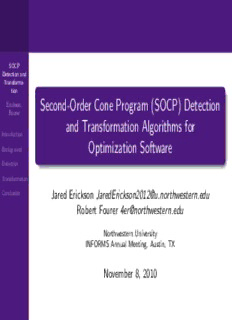
Second-Order Cone Program (SOCP) Detection and - Ampl PDF
Preview Second-Order Cone Program (SOCP) Detection and - Ampl
SOCP Detectionand Transforma- tion Second-Order Cone Program (SOCP) Detection Erickson, Fourer and Transformation Algorithms for Introduction Optimization Software Background Detection Transformation Conclusion Jared Erickson [email protected] Robert Fourer [email protected] NorthwesternUniversity INFORMSAnnualMeeting,Austin,TX November 8, 2010 SOCP Detectionand Transforma- tion 1 Introduction Erickson, Fourer Introduction 2 Background Background Detection Transformation 3 Detection Conclusion 4 Transformation 5 Conclusion Second-Order Cone Programs (SOCPs) SOCP Detectionand Transforma- tion Can be written as a quadratic program Erickson, Fourer Not positive semi-definite Introduction Convex Background Efficiently solvable with interior-point methods Detection Transformation SOCP general form: Conclusion minimize fTx subject to (cid:107)A x +b (cid:107)2 ≤ (cTx +d )2 ∀ i i i i i cTx +d ≥ 0 ∀ i i i Introduction SOCP Detectionand Transforma- Previous situation: tion Erickson, SOCPs can be written in numerous equivalent forms Fourer The form a modeler wants to use may not be the form a Introduction solver accepts Background Detection Converting the problem for a particular interior-point Transformation solver is tedious and error-prone Conclusion Ideal situation: Write in modeler’s form in a general modeling language Automatically transform to a standard quadratic formulation Transform as necessary for each SOCP solver Motivating Example SOCP Detectionand Transforma- (cid:113) (cid:113) tion minimize (x +2)2+(y +1)2+ (x +y)2 Erickson, Fourer Ampl model: Introduction Background var x; Detection var y; Transformation minimize objective: Conclusion sqrt((x+2)^2+(y+1)^2)+sqrt((x+y)^2); CPLEX 12.2.0.0: at2372.nl contains a nonlinear objective. KNITRO 6.0.0: Current feasible solution estimate cannot be improved. objective 2.12251253; 30 iterations; 209 function evaluations Motivating Example SOCP Detectionand Transforma- tion Original: Erickson, Fourer (cid:113) (cid:113) Introduction minimize (x +2)2+(y +1)2+ (x +y)2 Background Detection Transformed: Transformation minimize u+v Conclusion (x +2)2+(y +1)2 ≤ u2 (x +y)2 ≤ v2 u,v ≥ 0 Motivating Example SOCP Detectionand Transforma- tion Ampl model: Erickson, Fourer var x; var y; Introduction var u >= 0; var v >= 0; Background minimize obj: u+v; Detection s.t. C1: (x+2)^2+(y+1)^2 <= u^2; Transformation s.t. C2: (x+y)^2 <= v^2; Conclusion CPLEX 12.2.0.0: QP Hessian is not positive semi-definite. KNITRO 6.0.0: Locally optimal solution. objective 2.122027399; 3161 iterations; 3276 function evaluations Motivating Example SOCP Original: Detectionand Transforma- tion (cid:113) (cid:113) Erickson, minimize (x +2)2+(y +1)2+ (x +y)2 Fourer Introduction Transformed: Background minimize u+v Detection r2+s2 ≤ u2 Transformation Conclusion t2 ≤ v2 x +2 = r y +1 = s x +y = t u,v ≥ 0 Motivating Example SOCP Detectionand Ampl model: Transforma- tion var x; var y; Erickson, var u >= 0; var v >= 0; Fourer var r; var s; var t; Introduction minimize obj: u+v; Background s.t. C1: r^2+s^2 <= u^2; Detection s.t. C2: t^2 <= v^2; Transformation s.t. C3: x+2 = r; Conclusion s.t. C4: y+1 = s; s.t. C5: x+y = t; CPLEX 12.2.0.0: primal optimal; objective 2.121320344 5 barrier iterations KNITRO 6.0.0: Locally optimal solution. objective 2.122027305; 3087 iterations; 3088 function evaluations Generally Accepted SOCP Form SOCP Detectionand Transforma- SOCP general form: tion Erickson, minimize fTx Fourer Introduction subject to (cid:107)A x +b (cid:107) ≤ cTx +d ∀i i i i i Background Detection where Transformation x ∈ Rn is the variable Conclusion f ∈ Rn Ai ∈ Rmi,n bi ∈ Rmi c ∈ Rn i d ∈ R i
Description: